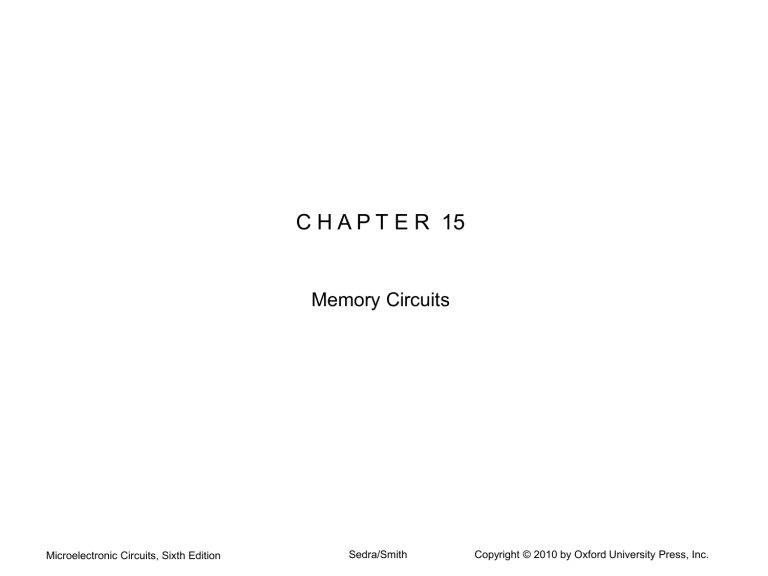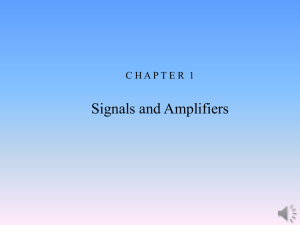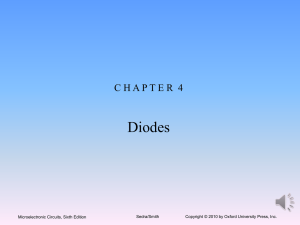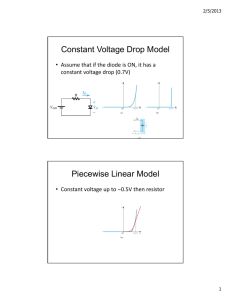Slide 1 - Oxford University Press

C H A P T E R 15
Memory Circuits
Microelectronic Circuits, Sixth Edition
Sedra/Smith Copyright © 2010 by Oxford University Press, Inc.
Figure 15.1 (a) Basic latch. (b) The latch with the feedback loop opened. (c) Determining the operating point(s) of the latch.
Microelectronic Circuits, Sixth Edition
Sedra/Smith Copyright © 2010 by Oxford University Press, Inc.
Microelectronic Circuits, Sixth Edition
Sedra/Smith Copyright © 2010 by Oxford University Press, Inc.
Microelectronic Circuits, Sixth Edition
Figure 15.3 (a) The set/reset (SR) flip-flop and (b) its truth table.
Sedra/Smith Copyright © 2010 by Oxford University Press, Inc.
Figure 15.4 CMOS implementation of a clocked SR flip-flop. The clock signal is denoted by ö .
Microelectronic Circuits, Sixth Edition
Sedra/Smith Copyright © 2010 by Oxford University Press, Inc.
Microelectronic Circuits, Sixth Edition
Sedra/Smith Copyright © 2010 by Oxford University Press, Inc.
Microelectronic Circuits, Sixth Edition
Sedra/Smith Copyright © 2010 by Oxford University Press, Inc.
Figure 15.7 A simpler CMOS implementation of the clocked SR flip-flop. This circuit is popular as the basic cell in the design of static random-access memory (SRAM) chips.
Microelectronic Circuits, Sixth Edition
Sedra/Smith Copyright © 2010 by Oxford University Press, Inc.
Microelectronic Circuits, Sixth Edition
Figure 15.8 A block diagram representation of the D flip-flop.
Sedra/Smith Copyright © 2010 by Oxford University Press, Inc.
Figure 15.9 A simple implementation of the D flip-flop. The circuit in (a) utilizes the two-phase non-overlapping clock whose waveforms are shown in (b).
Microelectronic Circuits, Sixth Edition
Sedra/Smith Copyright © 2010 by Oxford University Press, Inc.
Figure 15.10 (a) A master –slave D flip-flop. The switches can be, and usually are, implemented with CMOS transmission gates. (b) Waveforms of the two-phase nonoverlapping clock required.
Microelectronic Circuits, Sixth Edition
Sedra/Smith Copyright © 2010 by Oxford University Press, Inc.
Figure 15.11 A 2 M+N -bit memory chip organized as an array of 2 M rows × 2 N columns.
Microelectronic Circuits, Sixth Edition
Sedra/Smith Copyright © 2010 by Oxford University Press, Inc.
Microelectronic Circuits, Sixth Edition
Figure 15.12 A CMOS SRAM memory cell.
Sedra/Smith Copyright © 2010 by Oxford University Press, Inc.
Microelectronic Circuits, Sixth Edition
Sedra/Smith Copyright © 2010 by Oxford University Press, Inc.
Figure 15.14 The normalized value of V
Q versus the ratio (W/L )
5 determine the maximum value permitted for (W/L )
5
/( W/L )
1
/( W/L )
1 for the circuit in Fig. 15.13. This graph can be used to so that is V
Q kept below a desired level.
Microelectronic Circuits, Sixth Edition
Sedra/Smith Copyright © 2010 by Oxford University Press, Inc.
Figure 15.15 Voltage waveforms at various nodes in the SRAM cell during a read-1 operation.
Microelectronic Circuits, Sixth Edition
Sedra/Smith Copyright © 2010 by Oxford University Press, Inc.
Microelectronic Circuits, Sixth Edition
Sedra/Smith Copyright © 2010 by Oxford University Press, Inc.
Microelectronic Circuits, Sixth Edition
Sedra/Smith Copyright © 2010 by Oxford University Press, Inc.
Microelectronic Circuits, Sixth Edition
Figure 15.18 The one-transistor dynamic RAM (DRAM) cell.
Sedra/Smith Copyright © 2010 by Oxford University Press, Inc.
Figure 15.19 When the voltage of the selected word line is raised, the transistor conducts, thus connecting the storage capacitor C
S bit-line capacitance C
B
.
to the
Microelectronic Circuits, Sixth Edition
Sedra/Smith Copyright © 2010 by Oxford University Press, Inc.
Microelectronic Circuits, Sixth Edition
Sedra/Smith Copyright © 2010 by Oxford University Press, Inc.
Microelectronic Circuits, Sixth Edition
Sedra/Smith Copyright © 2010 by Oxford University Press, Inc.
Figure 15.22 An arrangement for obtaining differential operation from the single-ended DRAM cell. Note the dummy cells at the far right and far left.
Microelectronic Circuits, Sixth Edition
Sedra/Smith Copyright © 2010 by Oxford University Press, Inc.
Microelectronic Circuits, Sixth Edition
Sedra/Smith Copyright © 2010 by Oxford University Press, Inc.
Figure 15.24 The active-loaded MOS differential amplifier as a sense amplifier.
Microelectronic Circuits, Sixth Edition
Sedra/Smith Copyright © 2010 by Oxford University Press, Inc.
Figure 15.25 A NOR address decoder in array form. One out of eight lines (row lines) is selected using a 3-bit address.
Microelectronic Circuits, Sixth Edition
Sedra/Smith Copyright © 2010 by Oxford University Press, Inc.
Figure 15.26 A column decoder realized by a combination of a NOR decoder and a pass-transistor multiplexer.
Microelectronic Circuits, Sixth Edition
Sedra/Smith Copyright © 2010 by Oxford University Press, Inc.
Figure 15.27 A tree column decoder. Note that the colored path shows the transistors that are conducting when A
0 the address that results in connecting B
5 to the data line.
= 1, A
1
= 0, and A
2
= 1,
Microelectronic Circuits, Sixth Edition
Sedra/Smith Copyright © 2010 by Oxford University Press, Inc.
Figure 15.28 (a) A ring oscillator formed by connecting three inverters in cascade. (Normally at least five inverters are used.) (b) The resulting waveform. Observe that the circuit oscillates with frequency 1/ 6 tP
.
Microelectronic Circuits, Sixth Edition
Sedra/Smith Copyright © 2010 by Oxford University Press, Inc.
Figure 15.29 ( a) A one-shot or monostable circuit. Utilizing a delay circuit with a delay T and an XOR gate, this circuit provides an output pulse of width T. ( b) The delay circuit can be implemented as the cascade of N inverters where N is even, in which case T = N tP
.
Microelectronic Circuits, Sixth Edition
Sedra/Smith Copyright © 2010 by Oxford University Press, Inc.
Microelectronic Circuits, Sixth Edition
Figure 15.30 A simple MOS ROM organized as 8 words ×4 bits.
Sedra/Smith Copyright © 2010 by Oxford University Press, Inc.
Figure 15.31 (a) Cross section and (b) circuit symbol of the floating-gate transistor used as an EPROM cell.
Microelectronic Circuits, Sixth Edition
Sedra/Smith Copyright © 2010 by Oxford University Press, Inc.
Microelectronic Circuits, Sixth Edition
Sedra/Smith Copyright © 2010 by Oxford University Press, Inc.
Microelectronic Circuits, Sixth Edition
Figure 15.33 The floating-gate transistor during programming.
Sedra/Smith Copyright © 2010 by Oxford University Press, Inc.
Microelectronic Circuits, Sixth Edition
Figure P15.11
Sedra/Smith Copyright © 2010 by Oxford University Press, Inc.



